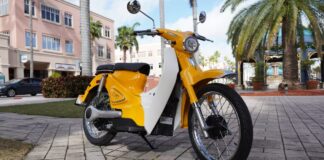The first fully electric commuter plane Alice from Eviation Aircraft (earlier post) successfully completed its maiden flight at Moses Lake, Washington. Alice lifted off on 27 Sep at 7:10 a.m. from Grant County International Airport (MWH), flying for a total of eight minutes and reaching an altitude of 3,500 feet.
Eviation Alice is targeted at commuter and cargo markets, and will typically operate flights ranging from 150 miles to 250 miles. Cape Air and Global Crossing Airlines, both US-based regional airlines, have placed orders for 75 and 50 Alice aircraft respectively. In 2021, DHL Express announced that it ordered 12 all-electric Alice eCargo planes from Eviation, making it Eviation’s first cargo customer.
Our compliments to Eviation on the successful first flight of Alice! Completing its maiden flight confirms our belief that the era of sustainable aviation is here. With our order of 12 Alice e-cargo planes, we are investing towards our overall goal of net-zero emissions logistics. Alice’s range and capacity makes it a unique sustainable solution for our global aviation network, supporting our aspiration to make a substantial contribution in reducing our carbon footprint and ultimately, achieving net-zero emissions by 2050.
—John Pearson, CEO DHL Express
The all-electric Alice aircraft features a maximum operating speed of 260 knots and a maximum useful load of 2,500 lbs for passenger version and 2,600 lbs for eCargo version.
Alice is available in three variants including a nine-passenger commuter, a six-passenger executive cabin, and an eCargo version. All configurations support two crew members. The executive cabin and eCargo variations are identical to the commuter configuration, except for the interior.
Alice is powered by two magni650 electric propulsion units (EPUs) from magniX, the only flight-proven electric propulsion systems at this scale. The magni650 EPU is a 850 SHP / 640 kW / 3,000 N·m – class EPU. Each EPU includes a magni650 motor, 4 X magniDrive 100, and a closed-loop integrated thermal management system.
The EPU is designed to provide the required torque and power turning at low RPMs, the same speed as the propeller. This allows a direct motor-to-propeller connection, eliminating the need for a heavy maintenance-prone gearbox.
A 4×3-phase architecture allows for redundancy, increased reliability and graceful degradation should a fault occur. For example, in the event of a short circuit, one 3-phase section can be turned off, allowing the pilot 75% of full power.
The magniDrive 100 is a multi-application, high-performance power electronics unit including both the inverter and motor controller functions. It is designed as ‘bi-directional’, capable of both DC/AC operation for propulsion and AC/DC operation for generation. It is suitable for HVDC networks of up to 800 VDC.
Designed for unpressurized operation, the magniDrive 100 combines high thermal performance, EMI immunity and lightning protection for metallic and composite structures. The magniDrive 100 can support both analog throttle inputs (for use in retrofits, for example) as well as Fly-By-Wire controls (for newly designed aircraft).
Other key suppliers include AVL (battery support); GKN (wings); Honeywell (advanced fly-by-wire system, flight controls and avionics); Multiplast (fuselage); Parker Aerospace (six technology systems); and Potez (doors).
Alice’s advanced battery system is highly efficient and endlessly upgradeable enabling range improvements as battery technology evolves. The aircraft also incorporates a fly-by-wire cockpit, providing greater reliability and systems redundancy.












